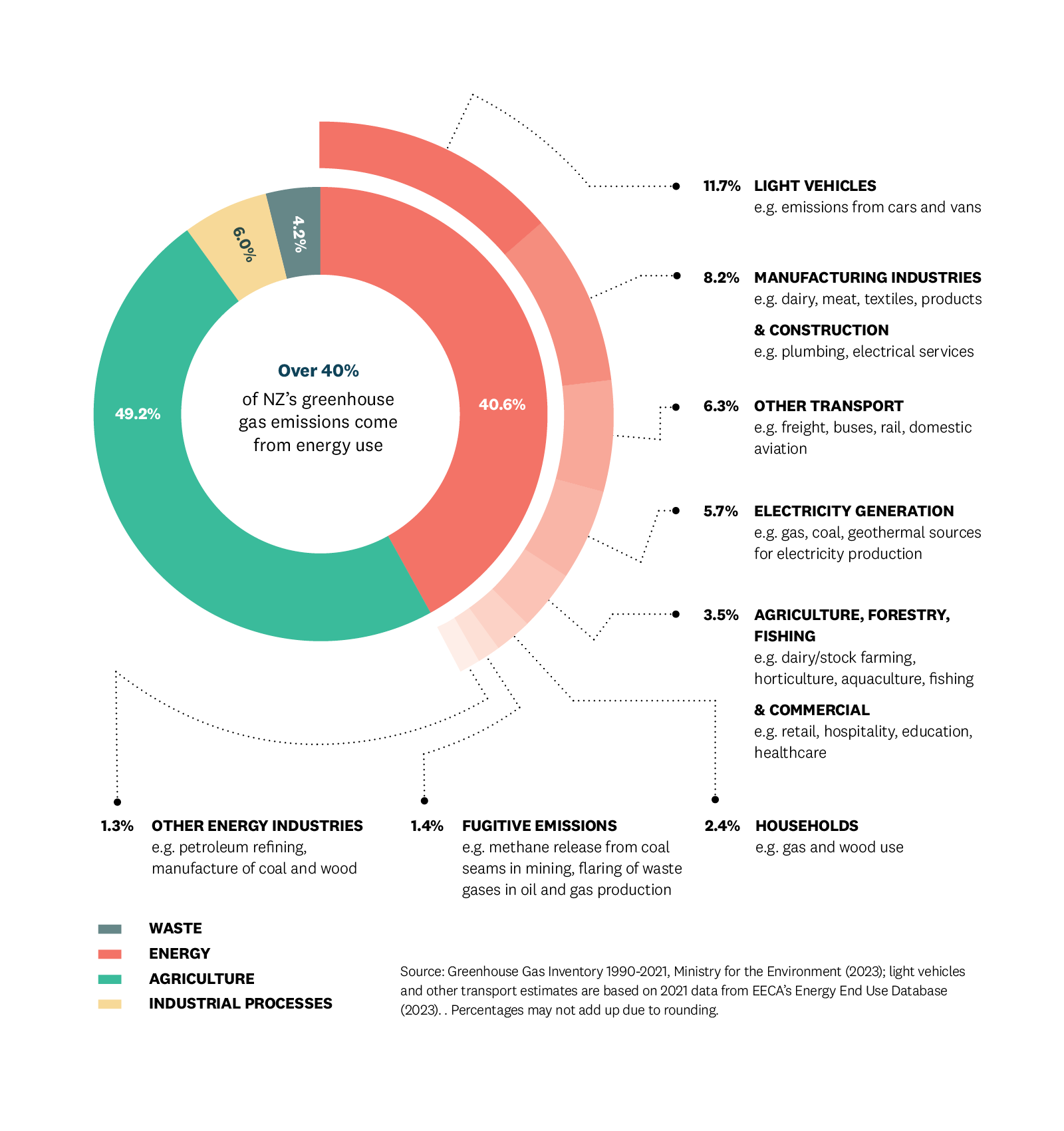Understanding climate change
Greenhouse gases act like a blanket around the earth, trapping warmth from the sun and making life possible. Our planet would freeze without greenhouse gases. But too high a concentration in the atmosphere increases earth’s temperature and causes climate change.
Our stable climate has allowed humanity to flourish. With a perfect range of mean temperatures, we’ve been able to stay in one place, develop agriculture, and build societies. But in just 150 years, industrialisation, deforestation, large-scale agriculture and huge population growth have pushed greenhouse gases to levels not seen in three million years.
Recent years have been the hottest on record. Extreme climate events — floods, storms, droughts and coastal inundation — are becoming more common. The knock-on effects of climate change are expected to include food insecurity, mass migration, change in ecosystems and spread of diseases.
The importance of clean and clever energy
About 40% of New Zealand's total greenhouse gas emissions come from our energy use.
We create these greenhouse gases when we burn fossil fuels — whether driving a petrol car or diesel truck, travelling by plane, burning gas for manufacturing or burning coal to create electricity.
Reducing our energy-related emissions will be challenging. Although New Zealand is investing resources and effort into decarbonisation and renewable energy, much more needs to happen.
The make-up of energy-related emissions
Understanding the make-up of our energy-related emissions is crucial to accelerating our transition to a low-emissions economy. At EECA, we determine where we can make the biggest impact in the shortest amount of time, then take action.
Energy makes up about 40% of our emissions
See how that breaks down, below.

Reducing emissions from energy
Our desired outcome is a sustainable energy system that supports the prosperity and wellbeing of current and future generations.
Based on our energy scenario modelling, most of New Zealand's energy emissions can be eliminated by 2050 using existing technologies. The scenarios modelled show demand for fossil fuels will have halved. Transport, which makes up around half of all energy-related emissions, will be almost entirely fossil-fuel free, and people will get around on great public transport networks.
If people own a car, it will be electric, and we'll live in smart, fully electric homes, and work in comfortable, energy-efficient offices.
This model is based on the best data we have to date: as technology and pricing improve, and the transition continues worldwide, it's likely to look even better.
Energy in the future
2.06 minutes
Explore what our New Zealand Energy Scenario modelling tells us about our potential future energy system.
Renewable energy is a key opportunity
In New Zealand, around 80-85% of our electricity is generated from clean, renewable resources such as hydro, geothermal and wind. This is one of the highest rates in the world.
But we currently have to top this up by generating electricity from coal and gas, and we are reliant on fossil fuels for 99% of transport energy and around 60% of industrial energy. Increasing our supply and use of renewable, low carbon energy is critical in achieving our emissions targets.
How New Zealand generates electricity
- Hydro electricity is generated by driving water from rivers or dams through turbines.
- Geothermal captures underground heat and steam by tapping into wells several kilometres deep.
- Wind turbines generate no carbon emissions when in operation. The infrastructure is easy to build and remove compared to hydro and geothermal.
- Thermal electricity is generated almost entirely from high-emissions fuels — gas and coal.
Why using electricity efficiently matters
Using electricity more efficiently allows our renewable sources to go further. It also frees up capacity in the electricity system. This means more electricity is available at a cheaper cost, so it becomes more viable to switch from high-emissions fuels, such as petrol and coal, to electricity.
If more New Zealanders switched to energy efficient technology, like LED lighting and heat pumps, we could significantly reduce the cost of meeting our climate commitments and speed up the transition to a low-emissions economy.
New Zealand's climate change commitments
New Zealand has joined other nations in signing up to targets to reduce emissions. Under the 2016 Paris Agreement on climate change, New Zealand pledged to reduce emissions to 30 percent below 2005 levels by 2030.
-
Zero Carbon Act
To deliver on these commitments, Parliament passed the Climate Change Response (Zero Carbon) Amendment Act 2019 (known as the Zero Carbon Act). This laid out the framework to net zero emissions by 2050. -
Climate Change Commission
The Climate Change Commission is a Crown entity established under the Carbon Zero Act. It provides independent advice to government including five-yearly carbon budgets, and monitors government progress toward emissions and adaptation goals.
